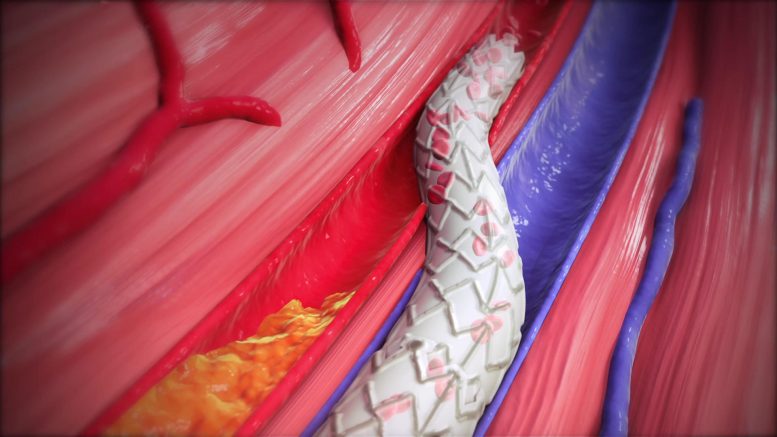
The system is designed to bypass blocked arteries in the leg and restore blood flow into the foot through the veins. Credit: LimFlow
According to a multicenter study published in the New England Journal of Medicine, an innovative treatment has enabled more than 75% of patients with the most severe form of peripheral artery disease to avoid amputation and retain their limbs.
An alternative to amputation called “limb salvage” for individuals with chronic limb-threatening ischemia (CLTI) was derived from the PROMISE II U.S. clinical trial, which evaluated the use of LimFlow technology in conducting transcatheter arterialization of the deep vein system. The trial concluded recently, and its findings were officially showcased at the VIVA (Vascular InterVentional Advances) conference in Las Vegas.
“This procedure is the only option for a subset of patients with severe vascular disease who are at risk for amputation of their limbs,” said the study’s co-principal investigator Daniel Clair, MD, professor and chair, Department of Vascular Surgery.
“Patients with long-standing diabetes and severe vascular disease in the foot itself often have no way to restore enough blood flow to the foot to heal wounds. In the past, a majority of these patients ended up losing their limbs,” he said.
The technique of arterialization of the veins was initially proposed over 100 years ago, but it was not until understanding that blood flow needed to be directed into the foot veins that limbs were able to be saved, Clair said.
An estimated 2 million Americans are living with CLTI. About one-third of amputees become depressed or anxious, and many experience “phantom pain” in the limb that is no longer there.
Nearly half of amputees from vascular disease will die within five years.
The PROMISE II U.S. trial studied 105 CLTI patients (43% Black, Hispanic, or Latino) treated with the minimally invasive system, designed to bypass blocked arteries in the leg and restore blood flow into the foot through the veins.
All patients were facing amputation prior to the procedure and had nonhealing wounds on their feet, often called diabetic ulcers. Clair said amputation-free survival in the trial was 66% because some of the patients expired without an amputation.
Researchers found that 76% of patients in the study were able to keep their legs and had completely healed or healing wounds six months post-procedure. Patient pain was also significantly reduced. Freedom from all-cause mortality was 87% at six months.
“As these patients tend to be elderly and increasingly frail, the ability to do this through the skin offers the chance to provide this procedure with a minimally invasive approach, offering quicker recovery and lower risk for wound problems and less disability,” Clair said.
“Now the majority of these patients can have their limbs and their independence saved with this approach to further reduce the risk of amputation for patients with vascular disease,” he said.
Reference: “Transcatheter Arterialization of Deep Veins in Chronic Limb-Threatening Ischemia” by Mehdi H. Shishehbor, D.O., M.P.H., Ph.D., Richard J. Powell, M.D., Miguel F. Montero-Baker, M.D., Anahita Dua, M.D., Jorge L. Martínez-Trabal, M.D., Matthew C. Bunte, M.D., Arthur C. Lee, M.D., Andrew S. Mugglin, Ph.D., Joseph L. Mills, M.D., Alik Farber, M.D. and Daniel G. Clair, M.D. for the PROMISE II Investigators, 30 March 2023, New England Journal of Medicine.
DOI: 10.1056/NEJMoa2212754









Be the first to comment on "Innovative New Treatment Helps Patients Avoid Leg Amputation"